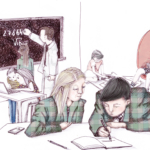
07 Sep Food Fraud: Can we trust the food we’re eating?
From counterfeit ingredients to misleading labels, the world of food can sometimes be a realm of deception.
Food fraud, a concerning issue, involves selling counterfeit or misleading food products to consumers. Surprisingly, even staples like honey can fall victim to this hidden menace.
In a marketplace where authenticity matters, food fraud has escalated, causing a staggering $3 billion annual dent in Australia’s economy, as reported by AgriFutures Australia. Seemingly innocent products like veal, wine, fish, and molluscs have been identified as high-risk categories, collectively causing economic losses estimated between $700 million and $1.3 billion each year.
As global trade networks grow more intricate, factors like geopolitics and the environment tighten the availability of raw ingredients, inadvertently opening doors for unscrupulous actors. Food microbiologist Associate Professor Julian Cox from UNSW School of Chemical Engineering warns that food fraud not only erodes consumer trust but can also pose serious health hazards. An unsettling example was the discovery of harmful chemicals in baby formula.
The art of food fraud encompasses six distinct practices: mislabelling, adulteration, substitution, counterfeiting, dilution, and concealment. Products may be adulterated by introducing foreign substances, or they may be falsely labelled ‘organic’ or ‘halal’ to command higher prices.
The fallout from food fraud can be significant. The UK’s supermarket chain, Booths, uncovered that imported beef had been deceitfully labelled as British, unveiling the vulnerability of even established supply chains. The prepacked slices of beef and deli products were actually from another country in Europe and South America, and the case is now being investigated by the UK’s National Food Crime Unit.
“You can pick almost any commodity, any food or beverage, and you can almost guarantee that products within that category have been tampered with somewhere along the supply chain – even if it’s in the labelling and claiming to be from a specific region of the world,” says A/Prof. Cox.
Throughout history, food adulteration cases have left a sour taste in consumers’ mouths. The infamous 2013 European meat scandal saw horse DNA found in beef burgers and lasagne. More tragically, China’s 2008 milk scandal revealed infant formulas tainted with melamine, resulting in infant deaths and tarnishing the nation’s food export reputation.
While it’s unfair to burden consumers with the task of verifying product authenticity, a healthy dose of scepticism can be a safeguard. Technologies like authenticity testing, combined with government regulations on pricing, could hold the key to minimizing such fraudulent practices.
In a world where the ingredients on your plate might not be what they seem, efforts to preserve the integrity of the food industry become paramount. Ensuring that the food your family consumes is genuine and safe becomes more than a choice – it becomes a necessity.




